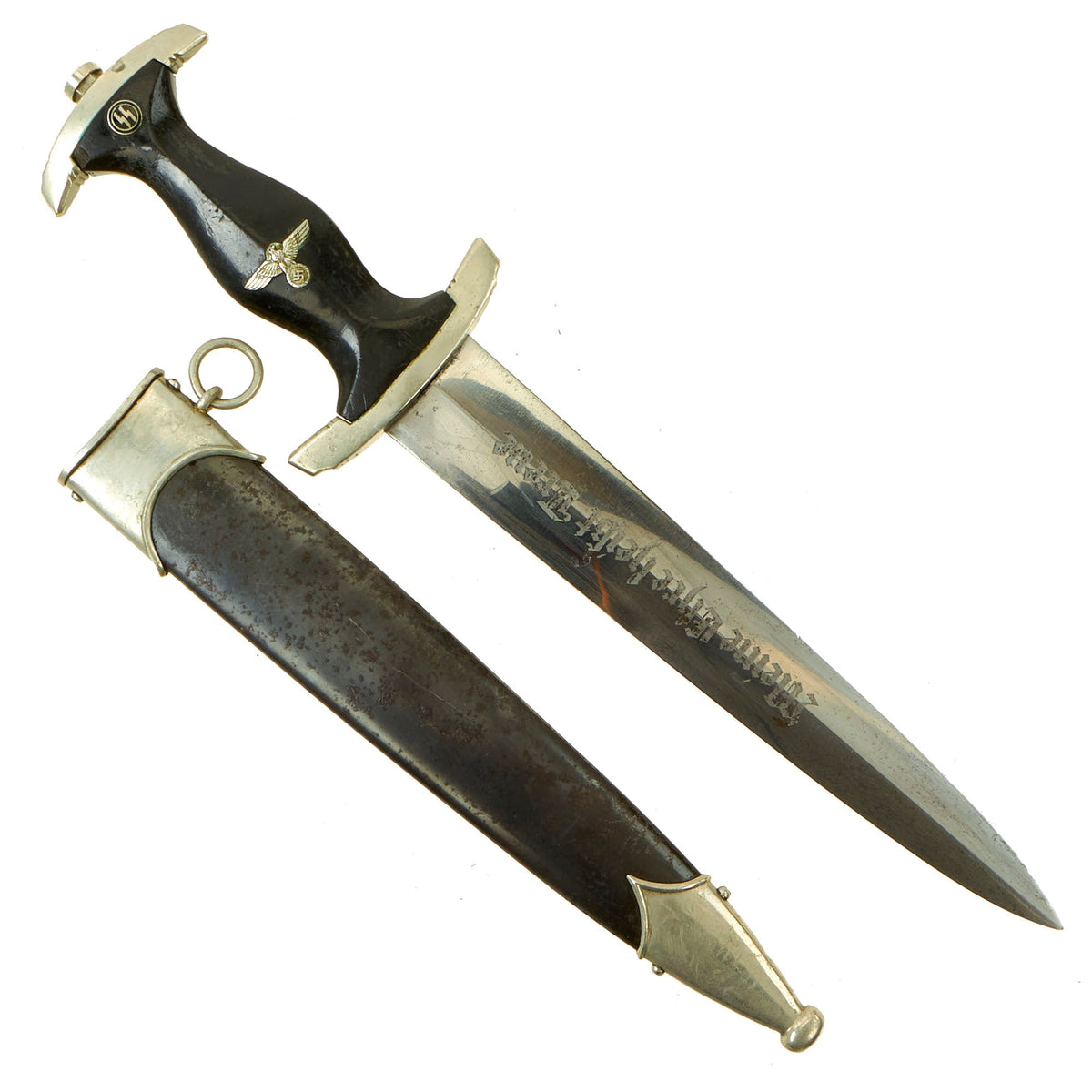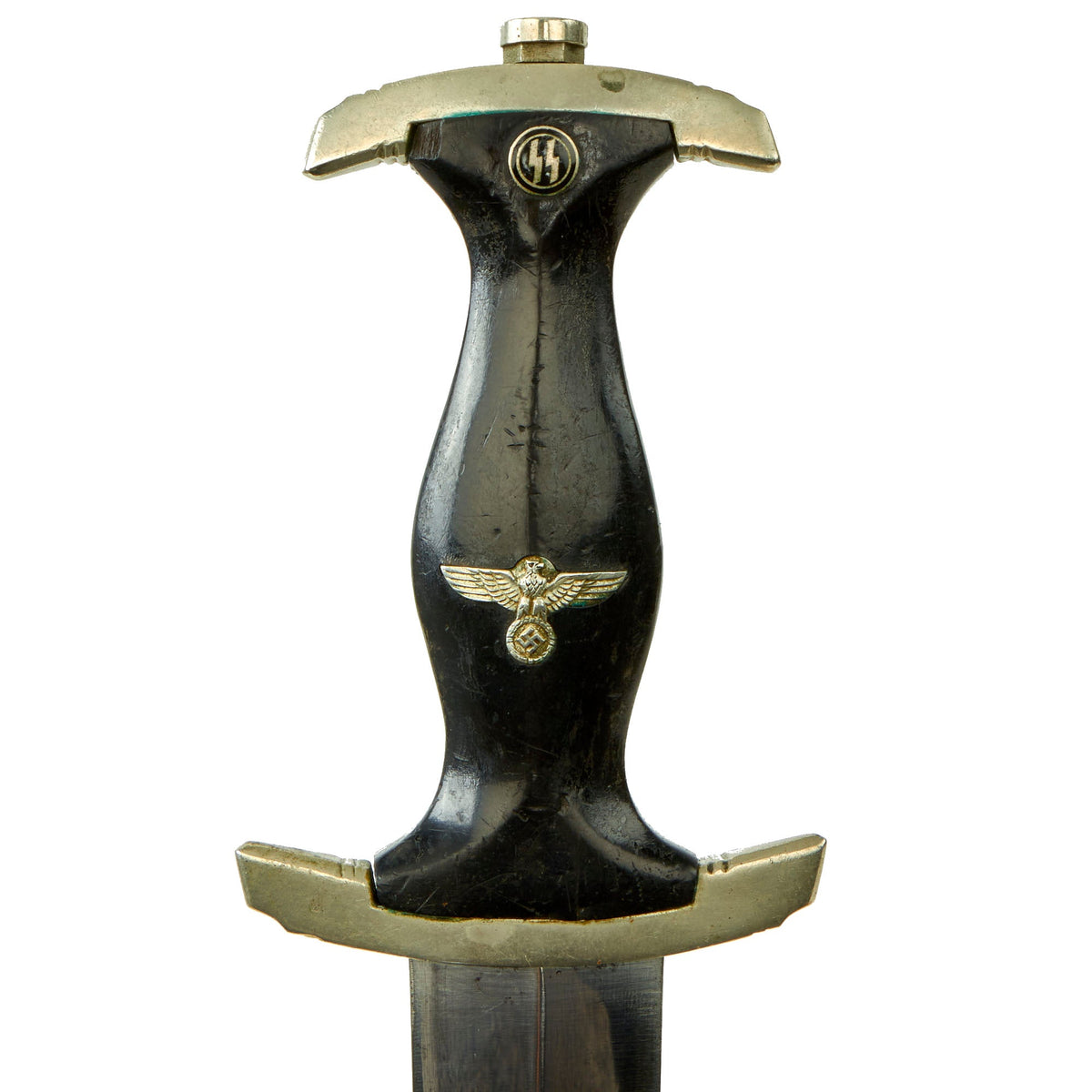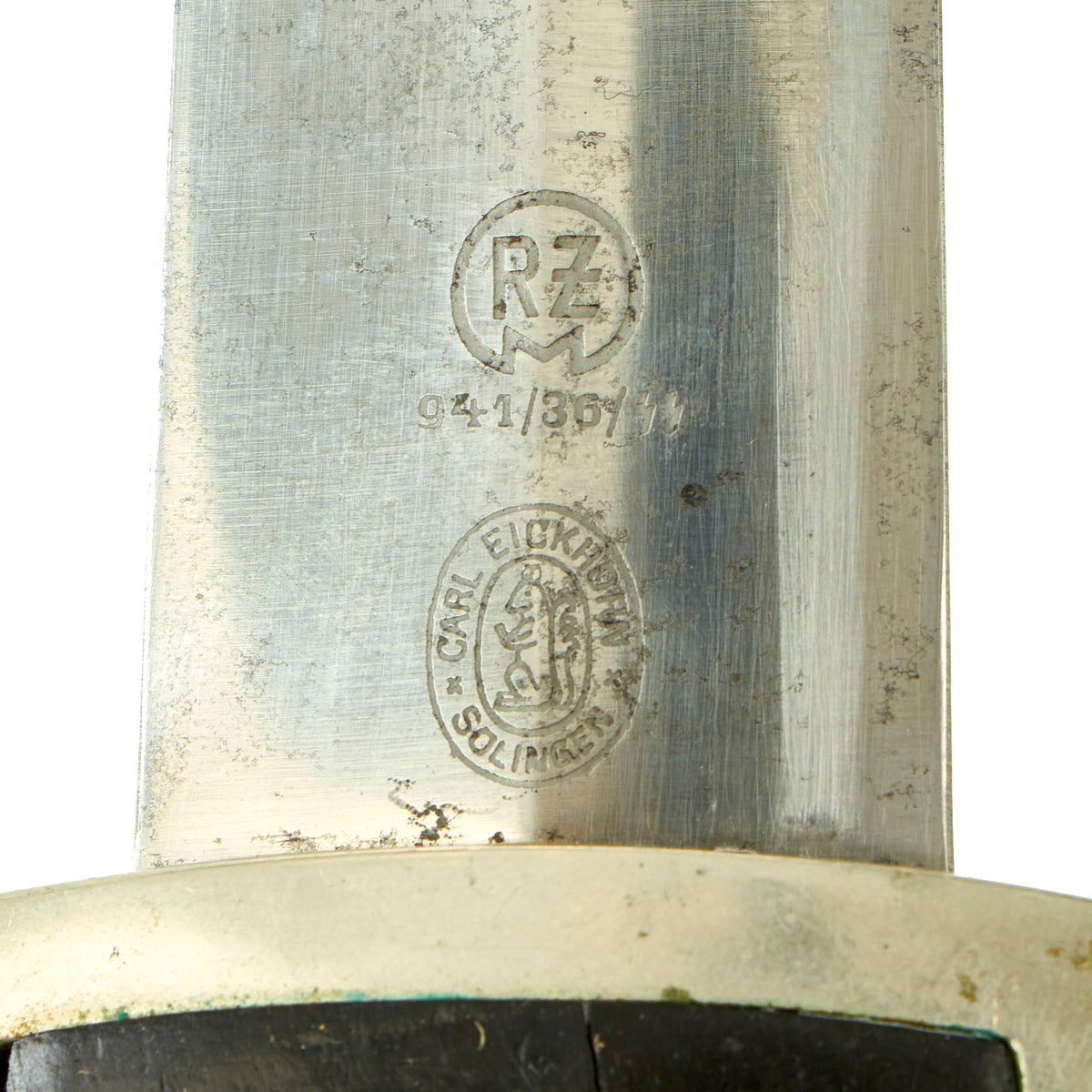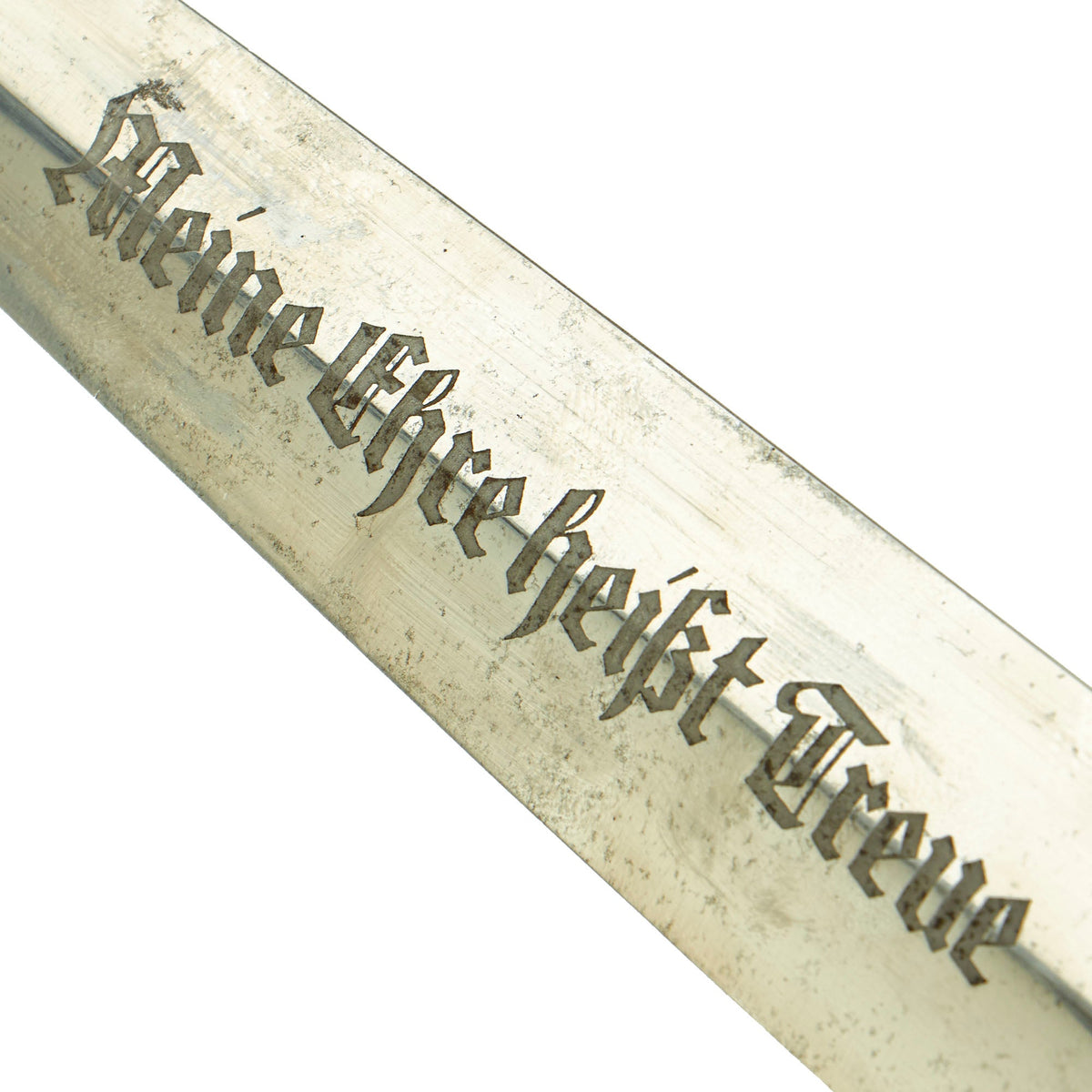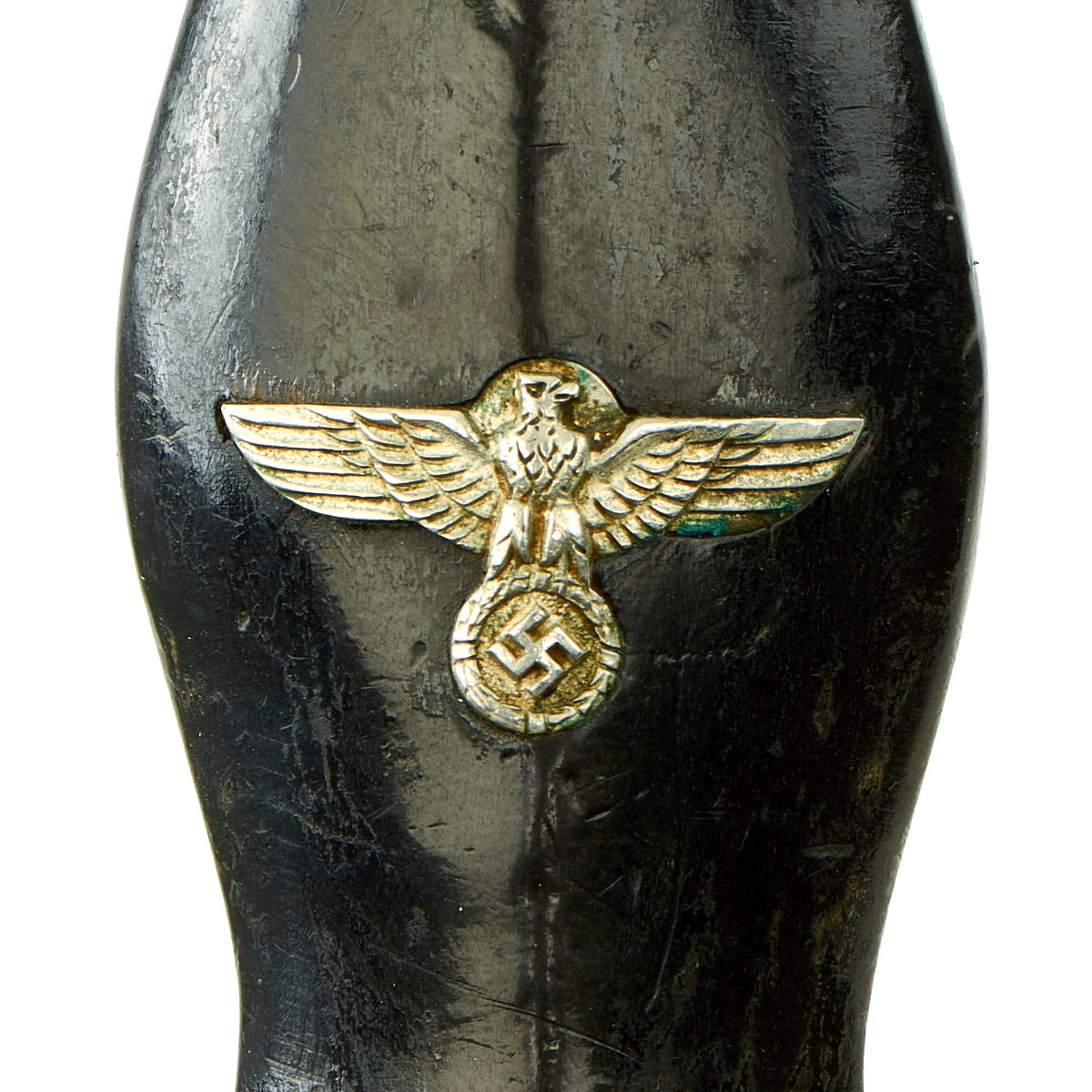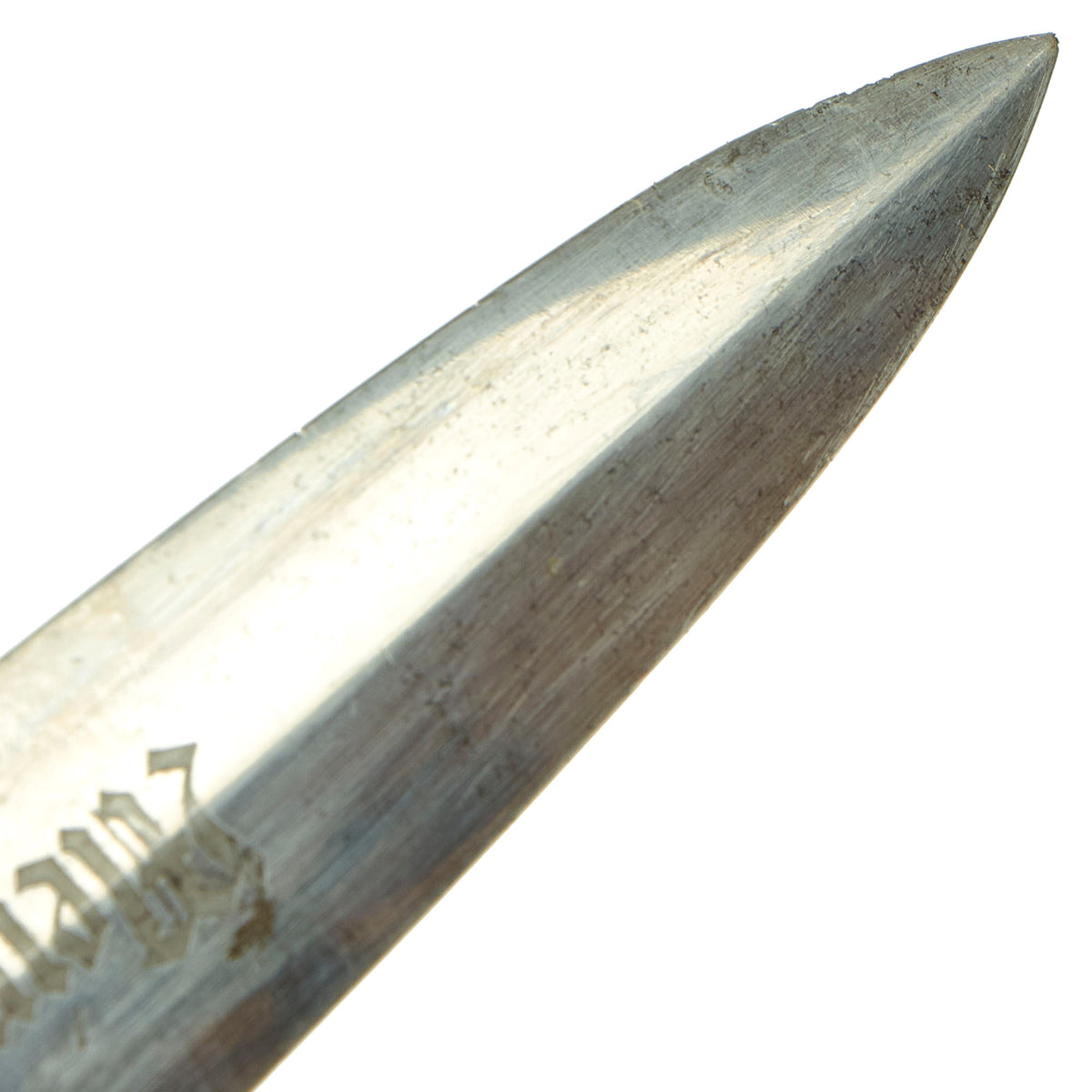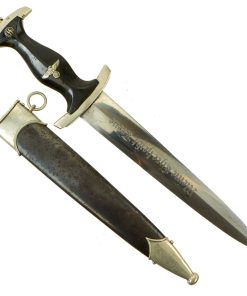Original German WWII Early Transitional Model 1933 SS Dagger by Carl Eickhorn with Scabbard – RZM 941 / 36 / SS Original Items
$ 3.695,00 $ 923,75
Original Item: Only One Available: The SS (Schutzstaffel) was originally formed in 1925, ostensibly to act as a small, loyal bodyguard unit to protect the Führer, Adolf AH. Under the direction of the Reichsführer-SS Heinrich Himmler, the SS grew to be the most ruthless and feared organization of the 20th century. They were the vanguard of Germany, and eventually controlled nearly every function of German life and much of Occupied Europe. The SS Dienstdolch (service dagger) was introduced in 1933. Early on, members of the SS were awarded their daggers during a ceremony at the Feldherrnhalle Memorial in Munich. The annual ritual, charged with mysticism and meant to evoke the traditions of medieval Teutonic knights, was held on 9 November, the date of the unsuccessful Munich Putsch of 1923. Both officers and enlisted men wore the identical dagger until 1936. After this time, only enlisted men wore the M1933 dagger.
The SS Dagger was originally equipped with nickel crossguards with an ebony wood grip. The black grip contained a National eagle with swas insignia recessed in the center area and an SS double sigrunne button inset at the top. On early examples the scabbard shell surface was factory blackened using a metal bluing process. The scabbard had nickel mounts. The SS blade was a polished type containing the SS motto, Meine Ehre Heisst Treue (My Honor is Loyalty). Early examples were mostly hand-fit. Production of later examples was more standardized, using cheaper, nickel-plated fittings with black painted scabbard shells. They could be held with a standard belt hanger, or a much rarer vertical hanger.
The blade on this lovely early production dagger remains partly bright, and is quite attractive. We often see these quite worn and oxidized, but not this example, which shows some scattered areas of oxidation and staining. The rear is marked with the RZM and SS contract information:
(RZM)
941/36/ᛋᛋ
Under the RZM marking the blade is etched with a 1933-35 Eickhorn trademark logo: a double oval surrounding a seated squirrel with a notched tail holding a sword, with CARL EICKHORN / SOLINGEN surrounding the squirrel trademark. Per J. Anthony Carter’s book GERMAN KNIFE AND SWORD MAKERS, this is one of several similar trademarks used during the period, and is exactly what would have been used on early SA, NSKK, and SS daggers signed by Röhm.
This legendary company was founded in 1865 by Carl Eickhorn, and is arguably the most famous of all Solingen makers. Not only could the family trace their history back 500 years, but they could also demonstrate involvement in the hardening and grinding industries for the same period. Truly the nobility of Solingen Edged weapon dynasties. Eickhorn edged weapons are the most desirable of all makers.
The blade still shows the original factory final polish crossgrain throughout the surface on both sides of the dagger, a real rarity! This texture is iconic, and is the definitive identifying characteristic for a real WWII German Blade. It has not been sharpened like some were by USGI’s, and still has the original edge, though there are a few very minor dents. There is a bit of speckled oxidation, but nothing major, and there is also some denting to the edge near the tip.
We often see these blades completely worn, so we would consider this blade to be in very good condition. The etched SS motto, Meine Ehre heißt Treue (My honor is loyalty) is crisp, however cleaning has removed some of the factory darkened finish. The blade shoulders perfectly meet the lower crossguard contour. The blade is solidly held in the hilt.
The crossguards of this dagger and tang nut are in good condition throughout, and are of the early war solid nickel silver construction. There is no evidence that they are plated, and the accent grooves are hand executed. The pommel nut is non magnetic, and also looks to be solid nickel silver. The fittings show oxidation overall probably from not being cleaned and then put into long storage. This dagger was produced too late to have a district number on the crossguard. We also checked inside the guards, as our customers often request, and both are marked inside with A and R on the inside, a marking we have seen before on SS daggers.
The ebony grip is a very nice example with a great color, showing only some light chipping in a few areas and near the pommel guard the is a 3mm x 5mm chip. This is definitely far better than we usually see these, as black dyeing process for the grips unfortunately causes the ebony wood to become even more brittle than it is to begin with, so damage is very common. The silvered ᛋᛋ doppelte Siegrune (Double Sig/Victory Rune) symbol and double circles are in great shape, with intact plating and enamel, showing just a bit of oxidation around the edge. The grip eagle is the “high-necked” type with the beak pointing slightly up. It remains in good condition, showing very little wear, just a bit of light scratching and a few dents, and looks to be solid nickel alloy.
The scabbard shell is a very good example, showing only light wear from age and use. This scabbard is the correct early war type, which has a black “anodized” finish; the black anodized (blued) finish is still very well retained but shows areas of oxidation throughout. The matching solid nickel silver scabbard mounts are in good condition. The lower ball is undented which is very nice as the weaker nickel alloy used in early models (later ones used steel) is prone to denting. All four dome headed screws are present, and in good condition.
This is a great chance to own a very good condition SS dagger from the pre-war period made by the most legendary of all Solingen makers! Complete with a nice scabbard, this dagger is ready to display!
Specifications:
Blade Length: 8 3/4″
Blade Style: Double Edged Dagger
Overall length: 13 3/4”
Crossguard: 3”
Scabbard Length: 10”
The RZM, Reichzeugmeisterei, (National Equipment Quartermaster), was officially founded in June 1934 in Munich by the NSDAP, Nationalsozialistische Deutsche Arbeiterpartei, (National Socialist German Worker’s Party), as a Reich Hauptamt, (State Central Office), and was based on the earlier SA Quartermaster’s Department. The registry was based at the Brown house in Munich and NSDAP party headquarters in Berlin.
The functions of the RZM were not only to procure and distribute items to Party formations, but also to approve chosen designs and to act as a quality control supervisor to ensure items manufactured for the Party met required specification and were standardized. Starting in late 1934 items manufactured for the SS came under the quality control of the RZM and as a result were to be marked with the RZM/SS approval/acceptance mark. The M7 in the code stands for daggers, with Robert Klaas being contractor number 37.
Shortly after this, the SS started using a separate listing of contractors, and in 1943 the Waffen-SS assumed full control over their uniform item production and no longer fell under the authority of the RZM.
Fast Shipping with Professional Packaging
Thanks to our longstanding association with UPS FedEx DHL, and other major international carriers, we are able to provide a range of shipping options. Our warehouse staff is expertly trained and will wrap your products according to our exact and precise specifications. Prior to shipping, your goods will be thoroughly examined and securely secured. We ship to thousands clients each day across multiple countries. This shows how we're dedicated to be the largest retailer on the internet. Warehouses and distribution centres can be located throughout Europe as well as the USA.
Note: Orders with more than one item will be assigned a processing date depending on the item.
Before shipping before shipping, we'll conduct a thorough inspection of the items you have ordered. Today, the majority of orders will be delivered within 48 hours. The delivery time will be between 3-7 days.
Returns
The stock is dynamic and we cannot completely manage it because multiple stakeholders are involved, including our factory and warehouse. So the actual stock may alter at any time. It's possible that you may not receive your order once the order has been made.
Our policy is valid for a period of 30 days. If you don't receive the product within 30 days, we are not able to issue a refund or an exchange.
You can only return an item if it is unused and in the same state as the day you received it. You must have the item in its original packaging.
Related products
Uncategorized
Uncategorized
Uncategorized
Armored Burgonet Helmet & Polearm from Scottish Castle Leith Hall Circa 1700 Original Items
Uncategorized
Uncategorized
Uncategorized
Uncategorized
Uncategorized
Australian WWII Owen MK1 Machine Carbine SMG Custom Fabricated Replica with Sling Original Items
Uncategorized
Uncategorized
Uncategorized
Uncategorized
Uncategorized
Uncategorized
Uncategorized
Uncategorized
Uncategorized
